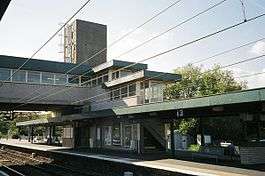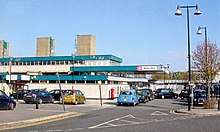Harlow Town railway station
Harlow Town railway station is on the West Anglia Main Line serving the town of Harlow in Essex, England. It is 22 miles 59 chains (36.6 km) down the line from London Liverpool Street and is situated between Roydon and Harlow Mill stations. Its three-letter station code is HWN.
| Harlow Town | |
|---|---|
 Platform 3 | |
| Location | |
| Place | Harlow |
| Local authority | Borough of Harlow |
| Coordinates | 51.781°N 0.095°E |
| Grid reference | TL446112 |
| Operations | |
| Station code | HWN |
| Managed by | Greater Anglia |
| Number of platforms | 4 |
| DfT category | C1 |
| Live arrivals/departures, station information and onward connections from National Rail Enquiries | |
| Annual rail passenger usage* | |
| 2014/15 | |
| 2015/16 | |
| 2016/17 | |
| 2017/18 | |
| 2018/19 | |
| History | |
| Key dates | Opened 1842 |
| Listed status | |
| Listed feature | Harlow Town Station including Platform Structures |
| Listing grade | Grade II listed |
| Entry number | 1117351[1] |
| Added to list | 25 November 1995 |
| National Rail – UK railway stations | |
| * Annual estimated passenger usage based on sales of tickets in stated financial year(s) which end or originate at Harlow Town from Office of Rail and Road statistics. Methodology may vary year on year. | |
The station and all trains serving it are operated by Greater Anglia.
History
The station was opened in 1842 as Burnt Mill, to serve the small village of the same name.

Between March 1959 and July 1960 the station was rebuilt[2] to serve the post-war new town of Harlow, to designs by Paul Hamilton with John Bicknell and Ian Fraser of the British Railways (Eastern Region) architects department (chief architect: H. H. Powell). Described by Pevsner as "low, crisp and entirely ungimmicky", its architectural quality was recognised in 1996 when it was made a Grade II listed building. The listing entry states "the Eastern Region Architect's Department was the most creative branch of British Railways, designing a number of powerful modern stations in conjunction with the Region's electrification. The new station for Harlow New Town was the flagship of this achievement. It is a building with powerful spatial qualities, of especial interest particularly for its architectural design".[3]
The Architect and Building News in 1959[4] said the architects have aimed at expressing the beauty of continuous surfaces of natural materials and paintwork has been reduced to a minimum.
On 13 July 1960, the station was renamed Harlow Town. Its status as a listed building has meant that alterations to conform with the Disability Discrimination Act have had to be carried out sensitively to protect the original architectural conception.
Services

All services at the station are operated by Greater Anglia, although some are branded as Stansted Express. Trains are normally formed by Class 317 and Class 379 electric multiple units.
The typical off-peak service pattern in trains per hour is:
- 4 tph to London Liverpool Street (2 fast, 2 semi-fast)
- 2 tph to Stratford (stopping)
- 2 tph to Stansted Airport (fast)
- 2 tph to Cambridge (1 semi-fast, 1 stopping)
- 2 tph to Bishops Stortford (1 semi-fast, 1 stopping)
The station today
The station has four platforms. Platform 2 is for services towards London Liverpool Street and Stratford. Platform 3 is for services towards Stansted Airport and Cambridge. Platforms 1 and 4 are used less frequently for slow trains and as a Waiting loop for freight trains from the aggregate terminal a mile down the line, they are however used by a number of peak starting/terminating services to/from Liverpool Street or Stratford and by a few through trains northbound and southbound. Currently all platforms accommodate 12 car trains.
In December 2009 ticket barriers were installed at the station, to help reduce penalty fare evasion from the station. The platforms can accommodate 12 car trains.[5][6]
References
- Historic England, "Harlow Town Station including Platform Structures (1117351)", National Heritage List for England, retrieved 2 June 2019
- Lawrence, David (2018). British Rail Architecture 1948-97. Crecy Publishing Ltd. p. 76. ISBN 9780860936855.
- http://unlockingessex.essexcc.gov.uk/
- "British Railways Architecture". The Architect and Building News. 216 (13): 409. 1959.
- "Greater Anglia Route Utilisation Strategy" (PDF). Network Rail. Retrieved 8 May 2009.
- "National Rail Enquiries - Harlow Town station information". www.nationalrail.co.uk.
External links
- Train times and station information for Harlow Town railway station from National Rail
- Historic England. "Details from listed building database (1117351)". National Heritage List for England.
| Preceding station | Following station | |||
|---|---|---|---|---|
| Roydon | Greater Anglia West Anglia Main Line |
Harlow Mill | ||
| Tottenham Hale | Greater Anglia Stansted Express |
Bishops Stortford | ||